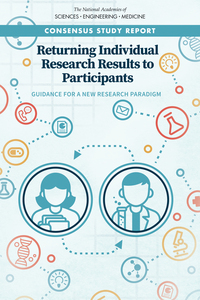When world famous cellist, Yo-Yo Ma, visited the NIH campus, he shared a story from the history of music, in which the peak of stringed instrument quality occurred in the late 17th century at a time of great collaboration and sharing of knowledge. When instrument makers began to compete, all of that changed: secrets of craftsmanship were held close and the quality of instruments plummeted. This decline lasted, according to Ma, until the 20th century, when again the free-flow of knowledge resumed. NIH Director Francis Collins noted, “There’s a lesson here about science.”
Data sharing is important. It is critical to continued progress in science, to maximize our investment in research, and to ensure the highest levels of transparency and rigor in science. But data sharing is a means to an end, not itself an end goal and, as such, needs to be done thoughtfully, in a way that fulfills the vision and mission of NIH and continues the advancement of treatments for disease and improvement of human health. NIH has long been on the forefront of making access to the results of our research accessible and has described our vision for expanding access to publications and data both in the 2015 NIH Plan for Increasing Access to Scientific Publications and Digital Scientific and in the 2018 Strategic Plan for Data Science.
The generation, analysis, and publication of data relates to the core function of NIH’s role as a biomedical research agency. Therefore, policies related to the management and sharing of data can have great impact across the agency and the research community. As such, it is critically important that we engage stakeholders on this complex topic. We began the conversation with the 2016 request for information on Strategies for NIH Data Management, Sharing, and Citation, and a 2017 joint workshop with the National Science Foundation that focused on the value of data sharing. Now we want to share with the community our current thinking about potential next steps in data management and sharing policy and seek your feedback on the best path forward.
Today, NIH released a notice in its Guide to Grants and Contracts that seeks public input on the key policy provisions that NIH is considering for inclusion in a future draft policy aimed at replacing NIH’s existing Data Sharing Policy. By obtaining robust stakeholder feedback we can help ensure that the future NIH policy will promote opportunities for data management and sharing while allowing flexibility for various data types, sharing platforms, and strategies. The information stakeholders provide can also assist us in developing streamlined approaches that could potentially reduce unnecessary administrative burdens.
While we appreciate and will consider any and all feedback our stakeholders provide, we are specifically interested in your thoughts on these key items:
- The definition of scientific data to be covered within these plans,
- The elements of required data management and sharing plans, and
- The optimal timing, including possible phased adoption, for NIH to consider in implementing various parts of a new data management and sharing policy, as well as how possible phasing could relate to needed improvements in data infrastructure, resources, and standards.
You can view our request for information, the key provisions and provide your comments by visiting Previously Compiled Public Comments. Comments will be accepted until December 10, 2018. In addition, NIH will also be hosting a webinar on the proposed provisions on November 7, 2018. Interested participants can find more details and register for the webinar here.
I often hear that policies seem to emerge from NIH fully formed, with little opportunity for the expertise and thoughts of the research community to come to come to bear. This RFI represents an opportunity to join the conversation before policy decisions are made. In the spirit of collaboration, embodied by 17th century Italian instrument makers, let’s work together to get this right.







